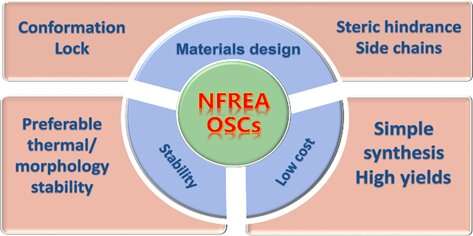Recent progress and material design of NFREAs-based OSCs provides valuable guidance for the construction of low-cost and high-efficiency active layer materials. Credit: Xiangjian Wan and Yongsheng Chen, Nankai University
Solar energy has been recognized as a promising green and renewable energy. Thanks to the synergistic innovation of active layer materials and device optimization techniques, organic solar cells (OSCs) have achieved great breakthroughs in the past decade and attracted widespread research attention. Though OSCs could effectively realize solar energy conversion, they are still not mature enough for large-scale applications.
To achieve high efficiency with low-cost in order to compete with silicon or perovskite solar cells, investigations focus on the structure-property relationship of non-fused ring electron acceptors (NFREAs) in OSCs. A team of scientists summarized the considerable progress of NFREA-based OSCs in recent years, and their work was published in Industrial Chemistry & Materials on Nov. 17, 2022.
"The development of low-cost and high-efficiency photovoltaic devices is crucial for conquering the problem of energy crisis and environmental pollution," said Xiangjian Wan, a Professor at Nankai University, "In this review, we systematically discussed the recent development of NFREA-based OSCs from the viewpoint of materials design, thus revealing the structure-property relationship to provide helpful guidance for material design and device optimization. We also provided an outlook on the remaining challenges to this field."
Active layer materials, especially non-fullerene acceptors (NFAs), play a critical role in solar-to-electric conversion, which has greatly accelerated the advancement of device performances in OSCs. Among them, the fused ring electron acceptors, such as ITIC, Y6, and their analogs have proven to be the most successful NFAs and have achieved efficiencies of over 19%.
This is mainly due to the good planarity and rigidity of those fused-ring acceptors, which can form stable geometric conformation and molecular packing. However, most of the fused-ring acceptors suffer from complicated synthetic procedures and unsatisfactory reaction yields and thus high preparation costs, which will substantially limit future applications.
In contrast, the price of commercialized silicon-based solar cells has continuously decreased in recent years and low cost is the outstanding advantage of perovskite solar cells. Although OSCs have many unique advantages, the cost issue has to be considered seriously for their successful commercialization. Therefore, it is necessary and urgent to design active layer materials from the perspective of not only efficiency but also cost.
"NFREAs typically adopted C-C single bond instead of the fused-ring conjugated skeleton, which greatly simplified the synthesis process and generally generate high reaction yields, in comparison with that of fused ones," Wan said,
"Presently, two efficient strategies have been established to suppress the torsion of C-C single bond and guarantee favorable planarity and rigid skeleton, that is to say the intramolecular non-covalent interaction by introducing suitable heteroatoms in the central core or the linking unit, and the steric hindrance by incorporating bulk side chains in the central core or the connecting unit."
"NFREAs-based OSCs have achieved continuous progress in recent years," explained Yongsheng Chen, a professor of Nankai University. "Following the similar design rationale of the widely used acceptor-donor-acceptor (A-D-A) architecture molecules that we have studied for over ten years, the state-of-the-art NFREAs can be roughly divided into A-π-D-π-A or A-π-A'-π-A architecture. Rational design and regulation of chemical structure of NFREAs could finely modulate the planarity, orientation, and packing properties, which exhibit the great potential to achieve a good balance between efficiency, cost, and even device stability," Chen said.
There is still plenty of room for new NFREAs in future molecular design. It is suggested to further design NFREAs by synergistically utilizing intramolecular noncovalent interaction and large steric hindrance and develop other novel architecture other than A-π-D-π-A or A-π-A'-π-A. Researchers think that new materials are still the most critical factor in promoting the rapid development of OSC performances, especially for the NFREA-based ones. And a deep understanding of the relationship between material structure and performance could provide valuable guidance for the upcoming low-cost and high-efficiency OSCs.
"In this review, our main goal is to provide readers with timely and accurate latest research progress and materials design strategies in this field," Chen said.
More information: Huanhuan Gao et al, Recent progress in non-fused ring electron acceptors for high performance organic solar cells, Industrial Chemistry & Materials (2022). DOI: 10.1039/D2IM00037G
Provided by Chinese Academy of Sciences
























